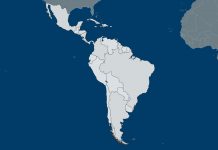Originally produced on March 19, 2018 for Mauldin Economics, LLC
By George Friedman and Allison Fedirka
Mexico’s northern borderlands have become notorious for their lawlessness. At times, it can seem that organized crime groups have as much control as the federal government. The drug trade is the easy and obvious explanation for this phenomenon, and it isn’t wrong—but it is incomplete.
Mexican governments have always had a difficult time ruling over the outer reaches of their domain. The Spanish Empire, which also had the capital of its Viceroyalty of New Spain in Mexico City, had similar issues. The Aztec Empire (also based in Mexico City, though it called it Tenochtitlan) would have encountered the same problem if it had gotten much larger. The common thread here isn’t narcotics; it’s geography. The region around Mexico City is the heartland of Mexico, but it’s also disconnected from the farthest reaches of the country by distance and mountains.
The Heartland and Beyond
Mexico is one of only two places in the world (the other is off the coast of Peru and Ecuador) that resides on or near the junctions of four tectonic plates—the Pacific, Cocos, Caribbean, and North American plates. This makes the country a hub for seismic activity, the cause of Mexico’s many mountain ranges and plateaus. The mountainous topography separates the country into regions with unique physical environments. In some areas, this hindered the development of population centers, and it has defined the culture as well as determined which economic activities are viable.
Narrow coastal plains and basins run along either side of the country. To the extreme northwest and southeast are the Baja California and Yucatan peninsulas, respectively. Just a short distance inland, three mountain ranges flank the mainland—the Sierra Madre Occidental in the west, the Sierra Madre Oriental in the east, and the Sierra Madre del Sur in the south. Between the western and eastern mountain ranges is the massive Mexican plateau.
Geographically, the Mexican plateau is a single feature; geopolitically, there’s a clear division between the northern and southern plateau regions. The Chihuahuan Desert dominates the northern plateau. It does not easily support large-scale vegetation, wildlife, or human populations. The southern plateau, on the other hand, sits at an altitude 3,000 feet (900 meters), which gives it a much more habitable climate, and its valleys to the south are among the most habitable in the country. Put these factors together and it makes sense that the valley south of the southern plateau region is the heart of Mexican civilization—in the past, as the center of the Aztec Empire, and today, still the geopolitical heartland of the country.
Homegrown Security
Mexico’s topography poses the same challenges to internal security that it does to central governance. Historically, Mexico City could not easily move large numbers of troops over vast distances and treacherous terrain, so it has had no choice but to rely on local forces to augment the national security forces. The Mexican states, in turn, have been conditioned to be self-reliant on security. From time to time, the isolation of some areas and subsequent feeling of alienation has engendered the creation of armed rebel groups, hoping to secede from or even overthrow the national government. Combined, these trends have led to a strong belief in homegrown security and skepticism of the national government. This strongly influences the way state and non-state actors respond to lapses in security in modern Mexico.
The reliance on local forces to augment central government forces dates back to Mexico’s colonial period, though initially it had less to do with the region’s terrain or vastness. Throughout the 17th and 18th centuries, Spain was engaged in multiple wars across Europe. The Spanish crown needed its troops for battles in the near abroad, and so once Mexico was considered conquered, Spain redirected military resources to its European endeavors. Much of the day-to-day security responsibilities were put in the hands of the colonists and local authorities. Mayors and business elites often funded irregular militias to help enforce security in the countryside and city centers.
Over time, Spain sent more regular troops over to Mexico, but mostly it tried arming and training locals to enforce security. By the early 19th century, near the start of Mexico’s war for independence, there were approximately 40,000 security forces in Mexico, only 6,000 of which were professional soldiers. The rest were from local militias. When Mexico’s independence movement took shape, it drew most of its fighting force from those local militias.
Once Spain was driven out, however, Mexico still faced the monumental task of unification. Many states were reluctant to answer to a central authority immediately after ridding themselves of Spanish rule. As a colony, economic activities had been poorly integrated—the states’ focus had been on shipping goods to Spain, not to each other. And the states had their own longstanding militias, whose members often had a strong affinity for their local authorities.
As a result, the newly formed Mexican government spent much of the 1830s and 1840s confronting secessionist movements. The central government was ill-equipped to deal with so many threats at once. Many state and local governments refused to pay more taxes and support a national army, preferring instead to maintain their own forces for defense. Large-scale rebellions erupted in Zacatecas and Tabasco, while republics temporarily formed in the territories of Texas, Yucatan, and Rio Grande. (Texas eventually joined the United States, Yucatan returned to Mexico, and Rio Grande split the difference—part went to Texas, the rest became the Mexican states of Coahuila, Nuevo Leon, and Tamaulipas.) Not coincidentally, all the areas where republics formed are far from the southern plateau region, and mountain ranges or deserts separate them from Mexico’s core.
Events later in the 19th and early 20th century—first a French effort to re-establish a monarch in Mexico, then the Mexican Revolution—reinforced the idea that local security forces must have a prominent role.
A Long Way from Intervention
A century later, the most vexing areas for the Mexican central government are those in the northern part of the country because of their proximity to the United States. The difference today is that the actors filling the power void aren’t concerned with self-governance; they’re organized crime groups fighting for turf, and vigilante groups fighting for peace. After so many instances in which local populations benefited from taking matters into their own hands, there is a sense of local entitlement to self-governance. The result has been widespread violence, the deterioration of local institutions, and a central government that depends more and more on the military to re-establish law and order.
As the violence creeps toward and exceeds historic levels, and uncertainty grows about the government’s ability to control it, the US is paying close attention to the potential for spillover. It’s not unheard of that the US would react to security threats emanating from across the border: Instability during Mexico’s revolution provoked a US military intervention in 1916, when the US Army sent a “Punitive Expedition” force to capture Pancho Villa.
But if that’s what it takes for the United States to intervene, we are a long way from intervention. At the time of its revolution, Mexico’s central government was extremely weak, and multiple border incursions had resulted in the killing of US citizens on US soil. Before Washington got involved, it pursued other measures such as putting more troops on the border, declaring martial law along the Texas border, and setting up blockades to prevent arms shipments from reaching Mexico. Today, its focus is on building a wall.








 The Geopolitics of the American President
The Geopolitics of the American President